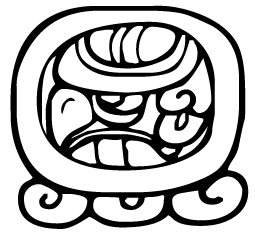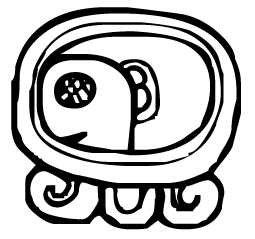The Maya civilization was a Mesoamerican civilization formed by the Maya peoples. It is known for its highly developed and sophisticated writing system, arts, mathematics, architecture, calendar and astronomical system. The oldest Mayan writings date back to 250 B.C.E., but historians believe they were written way before that.
Mayan symbols are significant archaeological findings in history. Moreover, they are a substantial source of material for the Central American civilization, helping piece their social, economic, political and agricultural practices together.
Archaeologists discovered hundreds of Mayan symbols carved on stone, allowing researchers to gain a perspective of their culture. Their writings consist of glyphs or symbols, and some of these symbols appear more often on their carved stone slab and temple walls. Some are considered powerful symbols. Mayan symbols and hieroglyphics came in different forms and shapes and were used for various purposes. Here are the most popular ones and what they mean.
Kawak

The Mayans believed in a rain god they called Chaak, who would strike clouds with his lightning ax to cause lightning and storm over Mesoamerica during the rainy season. They see rain as the one that brings good harvest and think highly about it. Kawak symbolizes the transformative ability of the rain and the catalyst behind the rainfall, lightning, clouds and thunder is Chaak. These combined atmospheric conditions are water blessings that transform, purify and lead to an abundant new life.
Kawak is also the nineteenth day of the Mayan calendar and a lucky day for friendship, family and healthy social relationships. In astrology, Kawak or Kawoq represents social groups such as family and society. It means that an individual relates to a bigger group other than himself.
Ahau

Primarily, Ahau is the sun symbol. The Mayans regard the sun highly, as they associate it with a “teacher” or “the light of knowledge.” They called their sun god Kinich Ahau, a powerful god in their temple and was considered an aspect of one of the creator gods called Itzamna. They believed Kinich Ahau would shine all day from the heavens and turn into a jaguar at night to pass through the underworld.
The sun would appear during the harvest season, and the Mayans believed it yielded abundant crops, warmed their souls and prospered their divinity. They would worship the sun, which also helped them tell time. In the Mayan calendar, Ahau is the twentieth day.
Etznab

Flint is a form of rock that is an integral part of Mayan living. The Mayans perfectly create flat, thin blades by chipping flint for ceremonial and sacrificial use. They do a reductive process that requires high concentration called knapping to produce flints without any error.
These flints were later called eccentric flints because of their complex shapes and fragility as cutting tools. Archaeologists found these flints in upper class’s tombs, and in underground caves as offerings. Eccentric flints were also found underneath stone monuments, marking significant dates in the society.
The Etznab represents flint, strength and courage. It is also a sign of grace and healing. In the Mayan calendar, it is the eighteenth day. As a material, flint was able to strike fire, so the Mayans valued it so much.
Kib

The Mayans were good at candle-making. They made large quantities of candles in different sizes to light their homes, caves, palaces, and temples and to perform religious rituals. They kept stingless bees for wax and honey and used the wax to make sweet-smelling candles. Kib is also a part of the Mayan calendar as the sixteenth day.
The Mayans used candles to incorporate the spiritual world into their ceremonies. For instance, in weddings, they would unite masculine or cosmic energy with feminine or mother earth. They would place four candles on the corners of an altar to represent the north, south, east and west.
Ix

It may seem like the face of a cute baby, but the Ix is actually the symbol of a jaguar, a highly regarded part of Maya culture. Ix is a sacred symbol that is associated with wisdom, vitality and the Mayan altar. In the Mayan calendar, Ix is the fourteenth day and may also be known as wizard or ocelot.
The Mayan culture considers the jaguar as the king of the forest, a revered animal associated with the god of the underworld and depicted as riding a huge cayman. The jaguar signifies divinity, strength and domain over all beings. They believed that the jaguar god ruled over the underworld at night and would rise from east to the west by daytime. The jaguar’s realms is the cosmic force of night and day and a symbol of dominance, leadership and confidence.
Chuwen

The Mayans were obsessed with time and calendars, and they were very precise in stating the date of the world’s creation, which, according to them, is August 13, 3114 BC. They also thought that the world had been created and destroyed three times. According to the Popol Vuh, the most significant holy text left in the Mayan civilization creation happened because of a dialogue between gods. The gods failed to shape human figures from clay or wood, so they created men with corn which became sacred to them as cereals.
Chuwen, also known as B’atz, is the god of creation in Mayan civilization. It represents destiny, life and its infiniteness. The Mayans believed that Chuwen created everything on earth and represents the nine months it takes for a child to develop from conception to birth. In their calendar, it marks the eleventh day.
Kaban

The Mesoamerican area is around a terrain surrounded by volcanoes that often cause earthquakes. The Mayans had to live with these forces they consider powerful. They recognized the earth and its unpredictability. Kaban was a representation of this literal force that the earth has, and its connection to humans. Kaban also signifies movement and natural shifts. It reminds them of a larger force at work, and during difficult circumstances, people need to have patience. This is also a symbol for knowledge and marks the seventeenth day on their calendar.
Another metaphor for the earth in Mayan culture was the caiman, a type of crocodile that evokes the likeness of mountainous areas coming from ancient waters. The Mayans believed that the various elements of the earth and terrestrials possessed spiritual strength.
Men

The Mayans associate the eagle with meditative thought. This symbol helps them access their inner wisdom when they focus on it. Known for the power of clarity, it leads to a clear mental focus. They regard this clear focus to make way for a higher telepathic state of mind.
Next to jaguar, the Mayans also revered the eagle among animals. The symbol Men is one of the most powerful among Mayan symbols. It represents the unity between the sun and moon. The Sun God Hunahpu Ahau, Kulkulan is the patron of Men. Its face is the Moon Goddess, which the Mayans associate with wisdom. Men also signifies integrity and unity, and a balance between feminine and masculine. On the Mayan calendar, it marks the fifteenth day.
Ok

Ok is the Mayan symbol of both the divine and human law. It takes a crucial place in their daily life, Mayan calendar and Mayan zodiac. The Mayans were very rigid about order and justice, which greatly manifested in their rigid society. Ok is the tenth day in the Mayan calendar.
The Mayans had their laws around 250 AD when they started to have leaders. They were very strict, so they generally have a peaceful civilization. They would punish those who break the laws by death, dropping the offender off a cliff. They also strangle villains using ropes or drop hard objects on their heads. Apart from death, the Mayans would enslave, cut their hair short or sell the offenders’ possessions.
Muluk

Muluk is also connected with Chaak, the rain god. It represents raindrops and is the ninth day on their calendar. Muluk is also associated with the gemstone jade as water’s partner in the life force. The Mayans valued rains so much, just like how they valued the sun.
They believed that the rain’s energy was placed into special pots and shielded by the followers of the rain god. As years pass, these pots burst their energy and bring rain. The Mayans performed rain rituals for rain deities. These are ceremonies where they ask for rain centers on a banquet of four boys for each cardinal point.